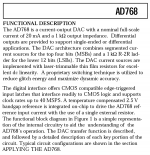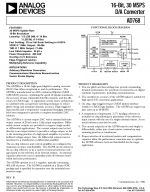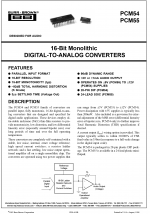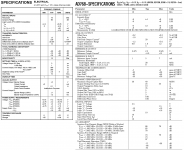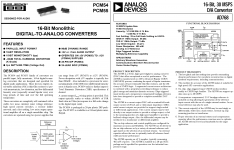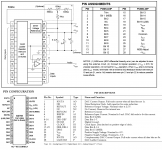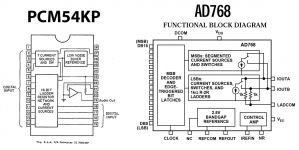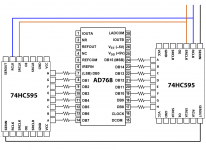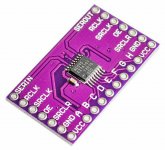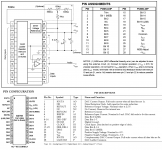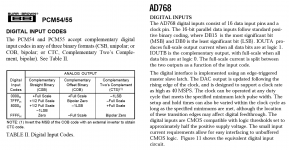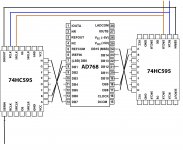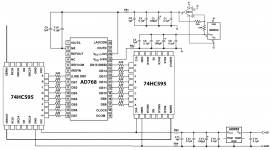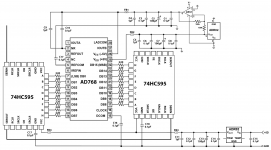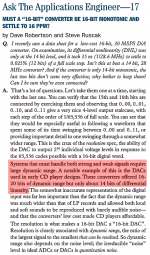Hi folks
In a moment of bored inactivity awaiting arrival of components for other projects I got to thinking about using the AD768 DAC for audio. It's 16-bit and uses parallel input, which, it occurs to me, is what the early Burr-Brown audio DACs like the PCM54 & PCM55 used.

Here's some extracts from the datasheets comparing the AD768 to the PCM54. I'm not sure how to compare many of the specs but I do not that the AD768 has 10x the output current of the PCM54.
In a moment of bored inactivity awaiting arrival of components for other projects I got to thinking about using the AD768 DAC for audio. It's 16-bit and uses parallel input, which, it occurs to me, is what the early Burr-Brown audio DACs like the PCM54 & PCM55 used.
Here's some extracts from the datasheets comparing the AD768 to the PCM54. I'm not sure how to compare many of the specs but I do not that the AD768 has 10x the output current of the PCM54.
Attachments
Current output is good, we can deal with that with the usual analogue output stage options, but what about the input?
I had a look at how manufacturers implemented the PCM54 in CD players, the Nakamichi OMS-7 mkII is a typical example, it uses a pair of 8-bit shift registers to turn the serial data into parallel inputs to the DAC chip.

So I thought, surely you could do the same thing with a couple of 74HC595 modules to feed the AD768.

It seems pretty straightforward how to split the serial data into parallel, but what about the other two signals of the 12S stream? How would they be passed from the 74HC595s to the AD768?
Here's a rough schematic I drew up, this is as far as I've got in thinking about how to feed I2S to an AD768:

I had a look at how manufacturers implemented the PCM54 in CD players, the Nakamichi OMS-7 mkII is a typical example, it uses a pair of 8-bit shift registers to turn the serial data into parallel inputs to the DAC chip.
So I thought, surely you could do the same thing with a couple of 74HC595 modules to feed the AD768.
It seems pretty straightforward how to split the serial data into parallel, but what about the other two signals of the 12S stream? How would they be passed from the 74HC595s to the AD768?
Here's a rough schematic I drew up, this is as far as I've got in thinking about how to feed I2S to an AD768:
Attachments
I'm watching with interest as I've a few AD768 which I still haven't gotten around to trying yet. I did think perhaps HC595s would be a good solution, but more recently I'm wondering if I can find an MCU with a 16bit wide parallel port.
The 20mA output current is a lot higher than typical audio DACs but there is plenty of output compliance available, given one suggested application is with passive I/V.
The 20mA output current is a lot higher than typical audio DACs but there is plenty of output compliance available, given one suggested application is with passive I/V.
Hi abraxalito, I'm glad you are interested as you are the only person I could find that even mentioned the AD768 in the same breath as audio, in fact, there is precious little mention of the AD768 in any application online.
After studying the AD768 datasheet it occurred to me that in many ways it was just like a 16-bit audio DAC, and the chips are available very cheap from China, so my interest was piqued.

The example in the AD768 datasheet of using an opamp to turn the differential current outputs into a unipolar 0-2V reminds me of how audio DAC outputs are often used and 0-2v is basically what we would be aiming for with audio, right?
The power supply and output stages are pretty simple to deal with I think, my main concern is the input. Feeding the data part of the i2s signal to the AD768 via a pair of 8-bit shift registers is straightforward enough, but I'm at a loss as to how to deal with the clock and latch parts of the i2s signal, I need to study the service manuals for CD players that employ pairs of parallel input DACs and hopefully I will figure it out.
I don't see any input on the AD768 for a latch signal, so I'm assuming it isn't needed, the clock input is pretty obvious, but I'm thinking it may be better to generate a new clock signal using a low jitter clock module rather then feed the i2s clock signal to the AD768's clock input.
I am wondering if I will need to do some reformatting of the i2s data signal using logic chips to make it acceptable to the AD768, I'll have to study the datasheets on the AD768 and the i2s spec to see how compatible they are or aren't.
Steep learning curve here, I've never done anything like this before, but I am enjoying learning.
After studying the AD768 datasheet it occurred to me that in many ways it was just like a 16-bit audio DAC, and the chips are available very cheap from China, so my interest was piqued.
The example in the AD768 datasheet of using an opamp to turn the differential current outputs into a unipolar 0-2V reminds me of how audio DAC outputs are often used and 0-2v is basically what we would be aiming for with audio, right?
The power supply and output stages are pretty simple to deal with I think, my main concern is the input. Feeding the data part of the i2s signal to the AD768 via a pair of 8-bit shift registers is straightforward enough, but I'm at a loss as to how to deal with the clock and latch parts of the i2s signal, I need to study the service manuals for CD players that employ pairs of parallel input DACs and hopefully I will figure it out.
I don't see any input on the AD768 for a latch signal, so I'm assuming it isn't needed, the clock input is pretty obvious, but I'm thinking it may be better to generate a new clock signal using a low jitter clock module rather then feed the i2s clock signal to the AD768's clock input.
I am wondering if I will need to do some reformatting of the i2s data signal using logic chips to make it acceptable to the AD768, I'll have to study the datasheets on the AD768 and the i2s spec to see how compatible they are or aren't.
Steep learning curve here, I've never done anything like this before, but I am enjoying learning.
Attachments
Last edited:
Use my schematic for the I2S to PCM splitting (16-Bits)
https://www.diyaudio.com/forums/dig...862-tht-i2s-input-nos-2r-148.html#post6533922
DB15 is the MSB, therefore change your schematic slightly
It seems, like the QA on the 595's is the latch (LE) ... hard to say
https://www.diyaudio.com/forums/dig...862-tht-i2s-input-nos-2r-148.html#post6533922
DB15 is the MSB, therefore change your schematic slightly
It seems, like the QA on the 595's is the latch (LE) ... hard to say
Attachments
The logic you need for generating the latching pulse (pin12 of HC595) might well be the same as or quite similar to the logic I used here for generating a latching pulse for the SPI interface of an MCU - Cheap ARM MCUs for RBCD audio
Thankyou guys, I shall spend today studying your work and then can hopefully use it to complete the digital side of my design.
In the meantime, I have redrawn the schematic, correcting the mistake Miro spotted and added the power supply circuits. I'm using ADR02 precision 5v references instead of the good old 7805. Any thoughts, comments or suggestions most welcome. I took the power supply circuitry from the datasheets for the AD768 and the REF02 voltage reference.

In the meantime, I have redrawn the schematic, correcting the mistake Miro spotted and added the power supply circuits. I'm using ADR02 precision 5v references instead of the good old 7805. Any thoughts, comments or suggestions most welcome. I took the power supply circuitry from the datasheets for the AD768 and the REF02 voltage reference.
Attachments
So what is the advantage of using AD768, other than that you might have a few around ?
It costs 56€ at Mouser right now, has 16 bits, with 4 LSB of linearity, ....
I would have thought that you are better off buying an AD1862 from Rochester ?
Or am I missing something ?
Cheers,
Patrick
It costs 56€ at Mouser right now, has 16 bits, with 4 LSB of linearity, ....
I would have thought that you are better off buying an AD1862 from Rochester ?
Or am I missing something ?
Cheers,
Patrick
You're missing that we both picked up some recycled ones which cost pennies. It would certainly be a big risk to shell out 56euro without knowing how it sounds.
Yes the linearity is a bit suspect but that can be largely fixed up with some software.
Yes, they cost very little from China, and I like the challenge of doing something different.
I also bought some AD1860s at the same time, but it's much less interesting to me and less challenging, to build a DAC around those.
Another thing to consider is that the AD768 has no digital filters built in, so if we use a receiver chip like the CS8416, you can have a completely clean digital side with no digital filtering at all. Whether this is a good thing and will sound better I don't know, and it of course, has implications for the filtering needed on the analogue side, but isn't it interesting to explore how a system built with no digital filters at all would sound?
On the linearity, here's a quote from an Analog Devices publication:
So the linearity of AD768 is about the same as the earlier 16-bit audio DACs.
Attachments
Last edited:
I have a very nice sounding analog stage running with my 36 paralleled TDA1387 design which could easily be transposed to a pair of AD768s. 18 TDA1387s gives 18mA total output swing which is very close to the 20mA output of the AD768 so only minor tweaks would be required.
I have a very nice sounding analog stage running with my 36 paralleled TDA1387 design which could easily be transposed to a pair of AD768s. 18 TDA1387s gives 18mA total output swing which is very close to the 20mA output of the AD768 so only minor tweaks would be required.
Excellent, that sounds like it would be highly suitable. I had been reading the AD811 and AD813 datasheets as they are claimed to be excellent buffers for ADCs and DAC but if you already have a design worked up that sounds good, then I would be sensible to adapt it.
Do you not think sending bipolar data to a unipolar device might be an issue ?
Not at all, one AD768 per channel, I've only shown one channel in the schematics as it goes without saying that you need two channels for stereo sound.
In CD players, the bipolar data is split into right and left channels by the digital filter placed in front of the DAC(s).
- Home
- Source & Line
- Digital Line Level
- AD768 as audio DAC
